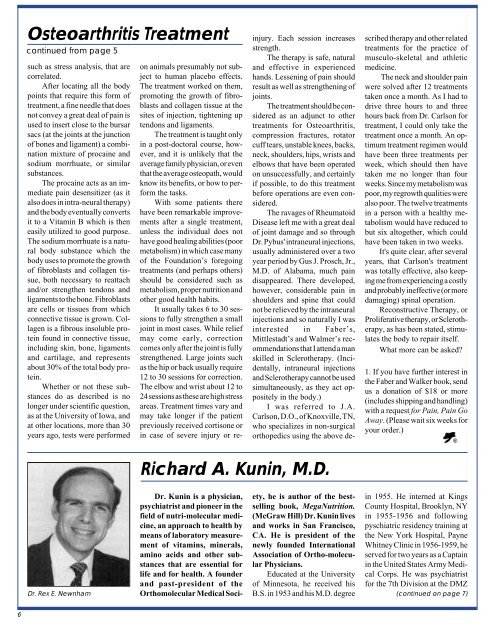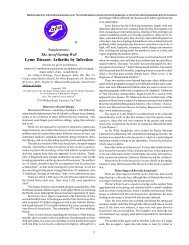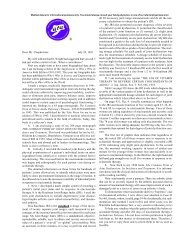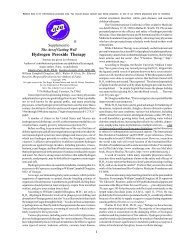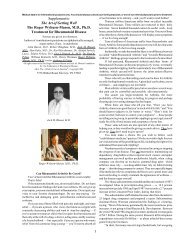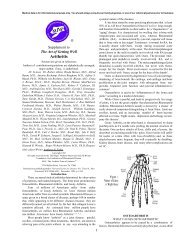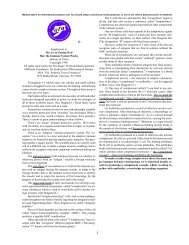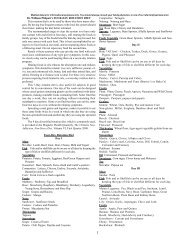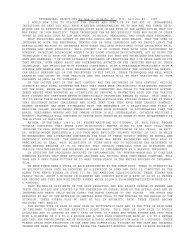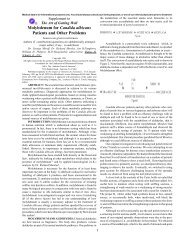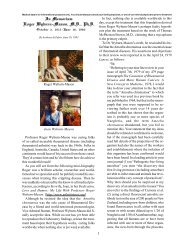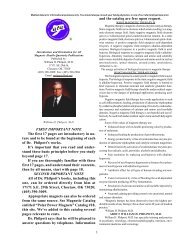June â 1994 â PDF - Arthritis Trust of America
June â 1994 â PDF - Arthritis Trust of America
June â 1994 â PDF - Arthritis Trust of America
Create successful ePaper yourself
Turn your PDF publications into a flip-book with our unique Google optimized e-Paper software.
Osteoarthritis Treatment<br />
continued from page 5<br />
on animals presumably not subject<br />
to human placebo effects.<br />
The treatment worked on them,<br />
promoting the growth <strong>of</strong> fibroblasts<br />
and collagen tissue at the<br />
sites <strong>of</strong> injection, tightening up<br />
tendons and ligaments.<br />
The treatment is taught only<br />
in a post-doctoral course, however,<br />
and it is unlikely that the<br />
average family physician, or even<br />
that the average osteopath, would<br />
know its benefits, or how to perform<br />
the tasks.<br />
With some patients there<br />
have been remarkable improvements<br />
after a single treatment,<br />
unless the individual does not<br />
have good healing abilities (poor<br />
metabolism) in which case many<br />
<strong>of</strong> the Foundation’s foregoing<br />
treatments (and perhaps others)<br />
should be considered such as<br />
metabolism, proper nutrition and<br />
other good health habits.<br />
It usually takes 6 to 30 sessions<br />
to fully strengthen a small<br />
joint in most cases. While relief<br />
may come early, correction<br />
comes only after the joint is fully<br />
strengthened. Large joints such<br />
as the hip or back usually require<br />
12 to 30 sessions for correction.<br />
The elbow and wrist about 12 to<br />
24 sessions as these are high stress<br />
areas. Treatment times vary and<br />
may take longer if the patient<br />
previously received cortisone or<br />
in case <strong>of</strong> severe injury or resuch<br />
as stress analysis, that are<br />
correlated.<br />
After locating all the body<br />
points that require this form <strong>of</strong><br />
treatment, a fine needle that does<br />
not convey a great deal <strong>of</strong> pain is<br />
used to insert close to the bursar<br />
sacs (at the joints at the junction<br />
<strong>of</strong> bones and ligament) a combination<br />
mixture <strong>of</strong> procaine and<br />
sodium morrhuate, or similar<br />
substances.<br />
The procaine acts as an immediate<br />
pain desensitizer (as it<br />
also does in intra-neural therapy)<br />
and the body eventually converts<br />
it to a Vitamin B which is then<br />
easily utilized to good purpose.<br />
The sodium morrhuate is a natural<br />
body substance which the<br />
body uses to promote the growth<br />
<strong>of</strong> fibroblasts and collagen tissue,<br />
both necessary to reattach<br />
and/or strengthen tendons and<br />
ligaments to the bone. Fibroblasts<br />
are cells or tissues from which<br />
connective tissue is grown. Collagen<br />
is a fibrous insoluble protein<br />
found in connective tissue,<br />
including skin, bone, ligaments<br />
and cartilage, and represents<br />
about 30% <strong>of</strong> the total body protein.<br />
Whether or not these substances<br />
do as described is no<br />
longer under scientific question,<br />
as at the University <strong>of</strong> Iowa, and<br />
at other locations, more than 30<br />
years ago, tests were performed<br />
injury. Each session increases<br />
strength.<br />
The therapy is safe, natural<br />
and effective in experienced<br />
hands. Lessening <strong>of</strong> pain should<br />
result as well as strengthening <strong>of</strong><br />
joints.<br />
The treatment should be considered<br />
as an adjunct to other<br />
treatments for Osteoarthritis,<br />
compression fractures, rotator<br />
cuff tears, unstable knees, backs,<br />
neck, shoulders, hips, wrists and<br />
elbows that have been operated<br />
on unsuccessfully, and certainly<br />
if possible, to do this treatment<br />
before operations are even considered.<br />
The ravages <strong>of</strong> Rheumatoid<br />
Disease left me with a great deal<br />
<strong>of</strong> joint damage and so through<br />
Dr. Pybus' intraneural injections,<br />
usually administered over a two<br />
year period by Gus J. Prosch, Jr.,<br />
M.D. <strong>of</strong> Alabama, much pain<br />
disappeared. There developed,<br />
however, considerable pain in<br />
shoulders and spine that could<br />
not be relieved by the intraneural<br />
injections and so naturally I was<br />
interested in Faber’s,<br />
Mittlestadt’s and Walmer’s recommendations<br />
that I attend a man<br />
skilled in Sclerotherapy. (Incidentally,<br />
intraneural injections<br />
and Sclerotherapy cannot be used<br />
simultaneously, as they act oppositely<br />
in the body.)<br />
I was referred to J.A.<br />
Carlson, D.O., <strong>of</strong> Knoxville, TN,<br />
who specializes in non-surgical<br />
orthopedics using the above described<br />
therapy and other related<br />
treatments for the practice <strong>of</strong><br />
musculo-skeletal and athletic<br />
medicine.<br />
The neck and shoulder pain<br />
were solved after 12 treatments<br />
taken once a month. As I had to<br />
drive three hours to and three<br />
hours back from Dr. Carlson for<br />
treatment, I could only take the<br />
treatment once a month. An optimum<br />
treatment regimen would<br />
have been three treatments per<br />
week, which should then have<br />
taken me no longer than four<br />
weeks. Since my metabolism was<br />
poor, my regrowth qualities were<br />
also poor. The twelve treatments<br />
in a person with a healthy metabolism<br />
would have reduced to<br />
but six altogether, which could<br />
have been taken in two weeks.<br />
It's quite clear, after several<br />
years, that Carlson's treatment<br />
was totally effective, also keeping<br />
me from experiencing a costly<br />
and probably ineffective (or more<br />
damaging) spinal operation.<br />
Reconstructive Therapy, or<br />
Proliferative therapy, or Sclerotherapy,<br />
as has been stated, stimulates<br />
the body to repair itself.<br />
What more can be asked<br />
1. If you have further interest in<br />
the Faber and Walker book, send<br />
us a donation <strong>of</strong> $18 or more<br />
(includes shipping and handling)<br />
with a request for Pain, Pain Go<br />
Away. (Please wait six weeks for<br />
your order.)<br />
®<br />
Richard A. Kunin, M.D.<br />
Dr. Rex E. Newnham<br />
Dr. Kunin is a physician,<br />
psychiatrist and pioneer in the<br />
field <strong>of</strong> nutri-molecular medicine,<br />
an approach to health by<br />
means <strong>of</strong> laboratory measurement<br />
<strong>of</strong> vitamins, minerals,<br />
amino acids and other substances<br />
that are essential for<br />
life and for health. A founder<br />
and past-president <strong>of</strong> the<br />
Orthomolecular Medical Society,<br />
he is author <strong>of</strong> the bestselling<br />
book, MegaNutrition.<br />
(McGraw Hill) Dr. Kunin lives<br />
and works in San Francisco,<br />
CA. He is president <strong>of</strong> the<br />
newly founded International<br />
Association <strong>of</strong> Ortho-molecular<br />
Physicians.<br />
Educated at the University<br />
<strong>of</strong> Minnesota, he received his<br />
B.S. in 1953 and his M.D. degree<br />
in 1955. He interned at Kings<br />
County Hospital, Brooklyn, NY<br />
in 1955-1956 and following<br />
pyschiatric residency training at<br />
the New York Hospital, Payne<br />
Whitney Clinic in 1956-1959, he<br />
served for two years as a Captain<br />
in the United States Army Medical<br />
Corps. He was psychiatrist<br />
for the 7th Division at the DMZ<br />
(continued on page 7)<br />
6


